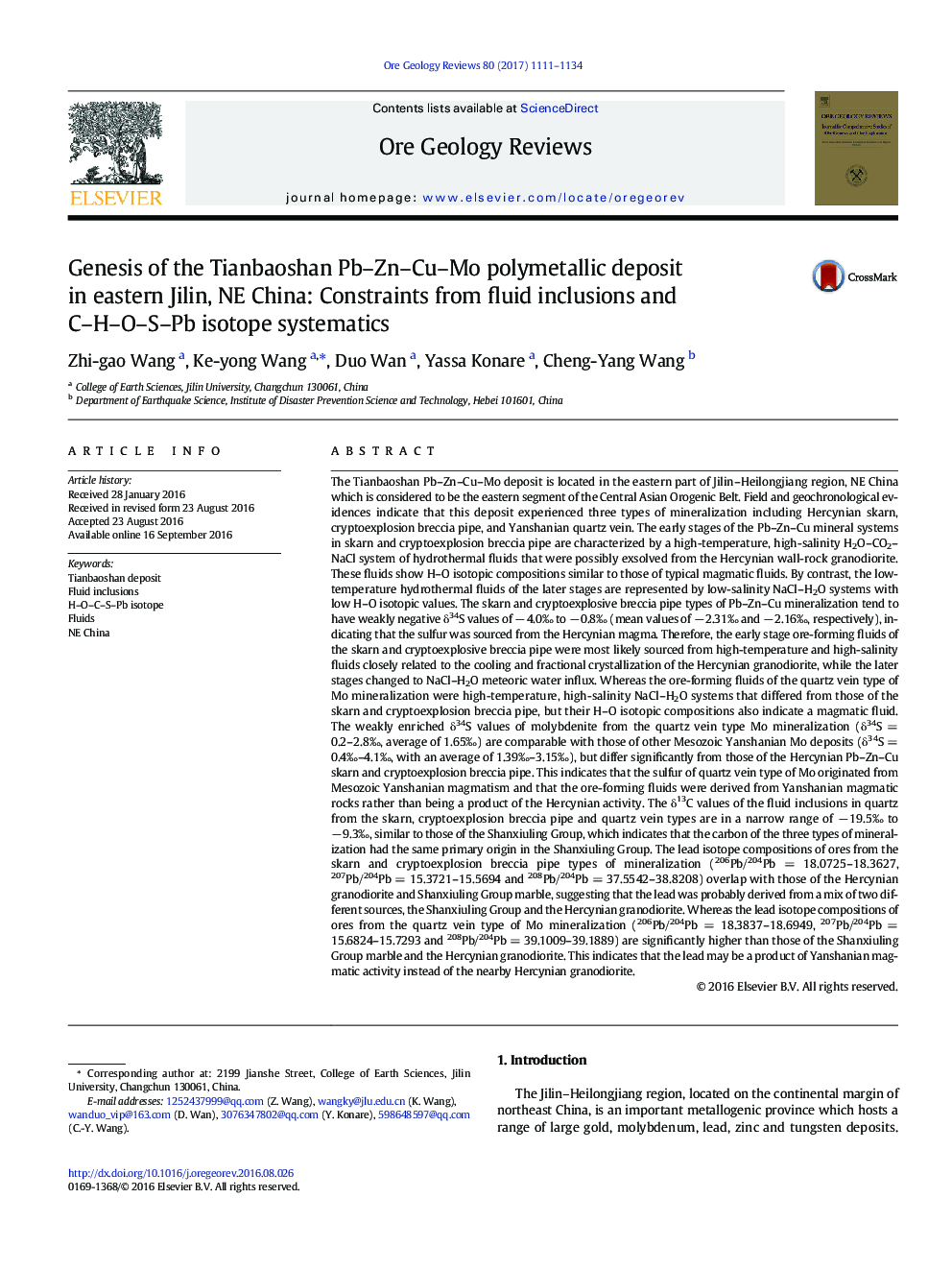| کد مقاله | کد نشریه | سال انتشار | مقاله انگلیسی | نسخه تمام متن |
|---|---|---|---|---|
| 6435691 | 1637226 | 2017 | 24 صفحه PDF | دانلود رایگان |

- Cu-Pb-Zn mineralization is related to Hercynian wall-rock granodiorite.
- Ore-forming fluids of Mo mineralization were derived from Yanshanian magmatism.
- Ore-forming materials originated from granitic magmas
The Tianbaoshan Pb-Zn-Cu-Mo deposit is located in the eastern part of Jilin-Heilongjiang region, NE China which is considered to be the eastern segment of the Central Asian Orogenic Belt. Field and geochronological evidences indicate that this deposit experienced three types of mineralization including Hercynian skarn, cryptoexplosion breccia pipe, and Yanshanian quartz vein. The early stages of the Pb-Zn-Cu mineral systems in skarn and cryptoexplosion breccia pipe are characterized by a high-temperature, high-salinity H2O-CO2-NaCl system of hydrothermal fluids that were possibly exsolved from the Hercynian wall-rock granodiorite. These fluids show H-O isotopic compositions similar to those of typical magmatic fluids. By contrast, the low-temperature hydrothermal fluids of the later stages are represented by low-salinity NaCl-H2O systems with low H-O isotopic values. The skarn and cryptoexplosive breccia pipe types of Pb-Zn-Cu mineralization tend to have weakly negative δ34S values of â 4.0â° to â 0.8â° (mean values of â 2.31â° and â 2.16â°, respectively), indicating that the sulfur was sourced from the Hercynian magma. Therefore, the early stage ore-forming fluids of the skarn and cryptoexplosive breccia pipe were most likely sourced from high-temperature and high-salinity fluids closely related to the cooling and fractional crystallization of the Hercynian granodiorite, while the later stages changed to NaCl-H2O meteoric water influx. Whereas the ore-forming fluids of the quartz vein type of Mo mineralization were high-temperature, high-salinity NaCl-H2O systems that differed from those of the skarn and cryptoexplosion breccia pipe, but their H-O isotopic compositions also indicate a magmatic fluid. The weakly enriched δ34S values of molybdenite from the quartz vein type Mo mineralization (δ34S = 0.2-2.8â°, average of 1.65â°) are comparable with those of other Mesozoic Yanshanian Mo deposits (δ34S = 0.4â°-4.1â°, with an average of 1.39â°-3.15â°), but differ significantly from those of the Hercynian Pb-Zn-Cu skarn and cryptoexplosion breccia pipe. This indicates that the sulfur of quartz vein type of Mo originated from Mesozoic Yanshanian magmatism and that the ore-forming fluids were derived from Yanshanian magmatic rocks rather than being a product of the Hercynian activity. The δ13C values of the fluid inclusions in quartz from the skarn, cryptoexplosion breccia pipe and quartz vein types are in a narrow range of â 19.5â° to â 9.3â°, similar to those of the Shanxiuling Group, which indicates that the carbon of the three types of mineralization had the same primary origin in the Shanxiuling Group. The lead isotope compositions of ores from the skarn and cryptoexplosion breccia pipe types of mineralization (206Pb/204Pb = 18.0725-18.3627, 207Pb/204Pb = 15.3721-15.5694 and 208Pb/204Pb = 37.5542-38.8208) overlap with those of the Hercynian granodiorite and Shanxiuling Group marble, suggesting that the lead was probably derived from a mix of two different sources, the Shanxiuling Group and the Hercynian granodiorite. Whereas the lead isotope compositions of ores from the quartz vein type of Mo mineralization (206Pb/204Pb = 18.3837-18.6949, 207Pb/204Pb = 15.6824-15.7293 and 208Pb/204Pb = 39.1009-39.1889) are significantly higher than those of the Shanxiuling Group marble and the Hercynian granodiorite. This indicates that the lead may be a product of Yanshanian magmatic activity instead of the nearby Hercynian granodiorite.
Journal: Ore Geology Reviews - Volume 80, January 2017, Pages 1111-1134